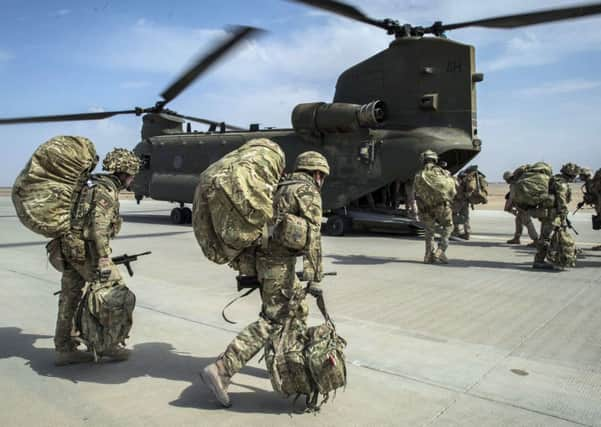‘Inevitable’ spending cuts will cut troop numbers by thousands


A report by the respected Royal United Services Institute (Rusi) said it was inevitable that Britain’s defence spending would drop below the Nato target of two per cent of GDP in the face of continuing austerity cuts.
It warned that up to 30,000 service personnel could go - with the Army likely to bear the heaviest cuts - leaving the armed forces with a combined strength of just 115,000 by the end of the decade.
Advertisement
Hide AdAdvertisement
Hide AdEven if defence spending is given the same level of protection being promised to health and schools, it said the forces are still likely to have shed 15,000 personnel over the next parliament.
Plans for equipment spending could also be affected, with the need to renew the Trident nuclear deterrent leaving other programmes vulnerable.
The findings are likely to increase the pressure on David Cameron from Tory MPs demanding the Conservatives go into the election with a manifesto commitment to maintain the Nato two per cent target.
However the Rusi paper said that would require an extra £3 billion of spending in 2016-17, rising to £5.9 billion a year in 2019-20.
Advertisement
Hide AdAdvertisement
Hide AdEven on current plans based on the assumption of a “modest” real-terms increase, the paper said that defence spending is set to dip to 1.85 per cent by 2017.
However it said an analysis of the three main parties’ spending plans suggested the Ministry of Defence could be facing a real-terms cut in its budget of up to 10 per cent over the next four years.
Past experience indicated that in such circumstances the Army was likely to suffer the most - potentially losing 20,000 of the estimated 30,000 military personnel who would face the axe.
If Royal Navy numbers were protected because of the need to crew the new aircraft carriers, the Army could find itself taking 80 per cent of the total reduction.
Advertisement
Hide AdAdvertisement
Hide AdIf, as the Conservatives have promised, the defence equipment budget is protected, the reductions in personnel would be even greater, rising to 42,000 for the forces as a whole leaving an Army of just 50,000.
The paper described cuts on such a scale as “perhaps the most pessimistic, but still plausible, scenario” in the current circumstances.
However, even under the “optimistic scenario” that defence was protected alongside health and schools, the paper said that there would have to be cutbacks of around 15,000 across the three services.
As a proportion of GDP, defence spending would be down to around 1.75 per cent by 2019 - a decrease of a third since 2010.
Advertisement
Hide AdAdvertisement
Hide AdA Government spokesman said: “With the second largest defence budget in Nato and the largest in the EU, the Government is committed to spending two per cent of GDP on defence.
“Decisions on spending after the financial year 2015/16 will be determined in the next spending review.
“Over the next decade we are committed to spending £163 billion on equipment and equipment support to keep Britain safe. That includes new strike fighters; more surveillance aircraft; hunter killer submarines; two aircraft carriers; and the most advanced armoured vehicles.”
He added: “The Prime Minister has said that he does not want to see our regular armed services reduced below the level that they are now and remains committed to growing the Reserves to 35,000.”